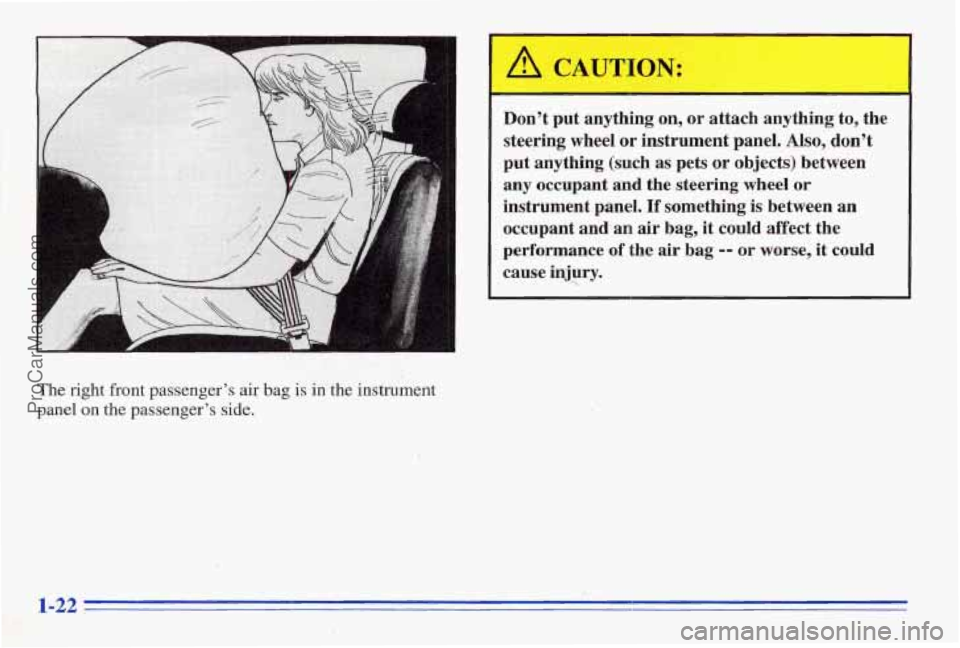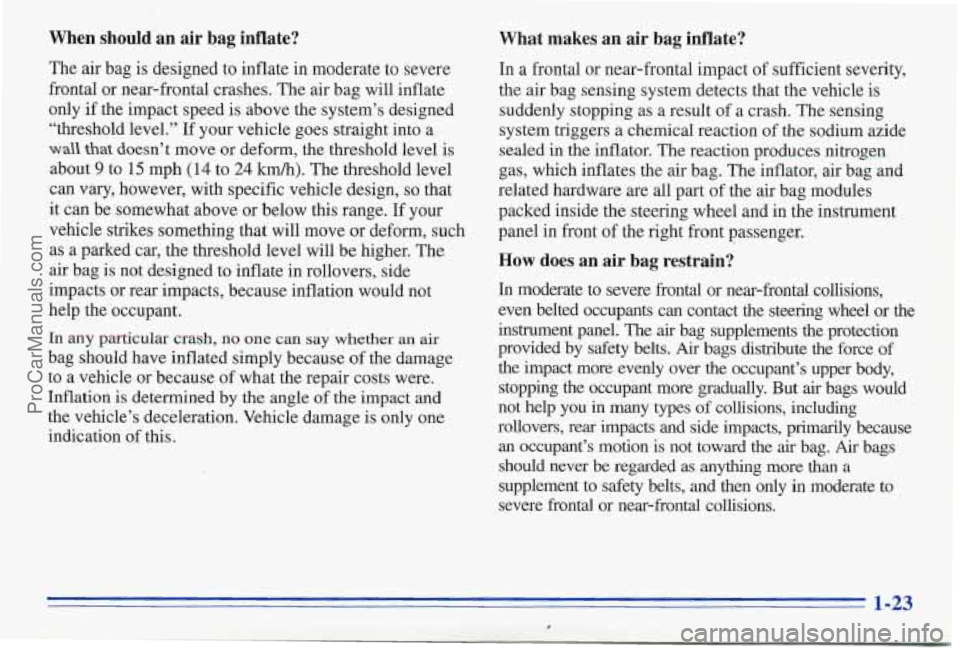PONTIAC FIREBIRD 1996 Owner's Manual
Manufacturer: PONTIAC, Model Year: 1996, Model line: FIREBIRD, Model: PONTIAC FIREBIRD 1996Pages: 386, PDF Size: 19.18 MB
Page 21 of 386

The lap part of the belt should be worn low and snug on
the hips, just touching the thighs. In a crash, this applies
force'to the
strong pelvic bones. And you'd be less likely
to slide under the lap belt. If you slid under it, the belt
would apply force at
your abdomen. This could cause
serious
or even fatal injuries. The shoulder belt should go
over the shoulder and across the chest. These parts.of the
body are best able to take belt restraining forces.
The safety belt locks if there's a sudden stop or crash.
On convertible models, the safety belt also locks if you
pull the belt
very quickly out of the retractor.
ProCarManuals.com
Page 22 of 386

@ What’s wrong with this?
I 1 I I 1 1 I I I I I I
You can be seriously hurt if your shoulder belt is
too loose. In
a crash, you would move forward
too much, which could increase injury.
The
shoulder belt should fit against your body.
A: The shoulder belt is too loose. It won’t give nearly
as much protection this way.
1-15
ProCarManuals.com
Page 23 of 386

@ What's wrong with this?
A: The belt is buckled in the wrong place.
A CAUTION:
You can be seriously injured if your belt is
buckled
in the wrong phce Iike this. In a crash,
the belt would
go up over your abdomen. The
belt forces would be there, not at the pelvic
bones.
This could cause serious internal
injuries. Always buckle your belt .into the
buckle nearest you.
..
1-16
ProCarManuals.com
Page 24 of 386

e.'' What's wrong with this?
i
I I I I I I I I I I I
A: The shoulder belt is worn under the arm. It should
be worn over the shoulder at all times.
You can be seriously injured if you wear the
shoulder belt under
your arm. In a crash, your
body would move too far forward, which would
increase the chance of head and neck injury.
Also, the belt would apply too much force to the
ribs, which aren't as strong as shoulder bones.
You could also severely injure internal organs
like your liver or spleen.
1-17
ProCarManuals.com
Page 25 of 386

Q: What’s wrong with this?
You can be seriously injured by a twisted belt. In
a crash, you wouldn’t have the full width of the
belt to spread impact forces.
If a belt is twisted,
make
it straight so it can work properly, or ask
your dealer to
fix it.
A: The belt is twisted acros’s the body.
1-1s
ProCarManuals.com
Page 26 of 386

Supplemental Restraint (SRS) System
This part explains the Supplemental Restraint (SRS)
system or air bag system.
Your Pontiac has two air bags
-- one air bag for the
I driver and another air bag for the right front passenger.
To unlatch the belt, just push the button on the buckle.
The belt should
go back out of the way.
Before you close the door, be sure the belt is out
of the
way. If you
slam the door on it, you can damage both the
belt and your vehicle.
1-19
ProCarManuals.com
Page 27 of 386

Mere are the most important things to know about the air
bag system:
You can be severely injured or killed in a crash if
you aren’t wearing your safety belt -- even if you
have an air bag. Wearing your safety belt during a
crash helps reduce your chance of hitting things
inside the vehicle
or being ejected from it. The air
bag is only a %upplemental restraint,’’ That is, it
works with safety belts but doesn’t replace them,
Air ,bags are designed to work only in moderate to
severe crashes where the front of your vehicle hits
something. They aren’t designed to inflate at dl in
rollover, rear, side or low-speed frontal crashes.
Everyone
in your vehicle, including the driver,
should wear
a safety belt properly - whether or
not there’s
an air bag for that person.
I
Air bags inflate with great force, faster than the
blink
of an eye. If you’re too close to an inflating
air bag,,it could seriously injure you. Safety belts
help keep you in position for an
air bag inflation
in a crash. Always wear your safety belt, even
with
an air bag. The driver should sit as far
back as possible while still maintaining control
of the vehicle.
I /II CAUTION:
An inflating air bag can seriously injure small
children. Always secure children properly in your
vehicle.
To read how, see the part of this manual
called “Children” and the caution label
on the
right front passenger’s safety belt.
1-20
ProCarManuals.com
Page 28 of 386

AIR
BAG
There is an air bag
readiness light on the
instrument panel, which
shows AIR BAG.
How the Air Bag System Works
The system checks the air bag’s electrical system for
malfunctions. The light tells
you if there is an electrical
problem. See “Air Bag Readiness Light” in the Index
for more information.
Where is the air bag?
The driver’s air bag is in the middle of the steering whee\
l.
1-21
ProCarManuals.com
Page 29 of 386

A
A
The right front passenger's air bag is in the instrument
panel on the passenger's side.
I
Don't put anything on, or attach anything to, the
steering wheel
or instrument panel. Also, don't
put'anything (such as pets or objects) between
any occupant and the steering wheel or
instrument, panel.
If something is between an
oc-cupant and an air bag, it could affect the
performance
of the air bag -- or worse, it could
cause injury.
ProCarManuals.com
Page 30 of 386

When should an air bag inflate?
The air bag is designed to inflate in moderate to severe
frontal or near-frontal crashes. The air bag will inflate
only
if the impact speed is above the system’s designed
“threshold level.”
If your vehicle goes straight into a
wall that doesn’t move or deform, the threshold level is
about 9 to 15 mph (14 to 24 km/h). The threshold level
can
vary, however, with specific vehicle design, so that
it can be somewhat above or below this range. If your
vehicle strikes something that will move or deform, such
as
a parked car, the threshold level will be higher. The
air bag is not designed
to inflate in rollovers, side
impacts or rear impacts, because inflation would not
help the occupant.
In any particular crash, no one can say whether an air
bag should have inflated simply because of the damage
to a vehicle or because
of what the repair costs were.
Inflation is determined by the angle
of the impact and
the vehicle’s deceleration. Vehicle damage
is only one
indication
of this.
What makes an air bag inflate?
In a frontal or near-frontal impact of sufficient severity,
the air bag sensing system detects that the vehicle
is
suddenly stopping as a result of a crash. The sensing
system triggers
a chemical reaction of the sodium azide
sealed in the inflator. The reaction produces nitrogen
gas, which inflates the air bag. The inflator, air bag and
related hardware are all part
of the air bag modules
packed inside the steering wheel and
in the instrument
panel in front of the right front passenger.
How does an air bag restrain?
In moderate to severe frontal or near-frontal collisions,
even belted occupants can contact the steering wheel
or the
instrument panel. The
air bag supplements the protection
provided by
safety belts. Air bags distribute the force of
the impact more evenly over the occupant’s upper body, stopping the occupant more gradually. But
air bags would
not help you in many types
of collisions, including
rollovers, rear impacts and side impacts, primarily because an occupant’s motion is not toward the
air bag. Air bags
should never be regarded
as anythmg more than a
supplement to safety belts, and then only in moderate to
severe frontal or near-frontal collisions.
1-23
ProCarManuals.com